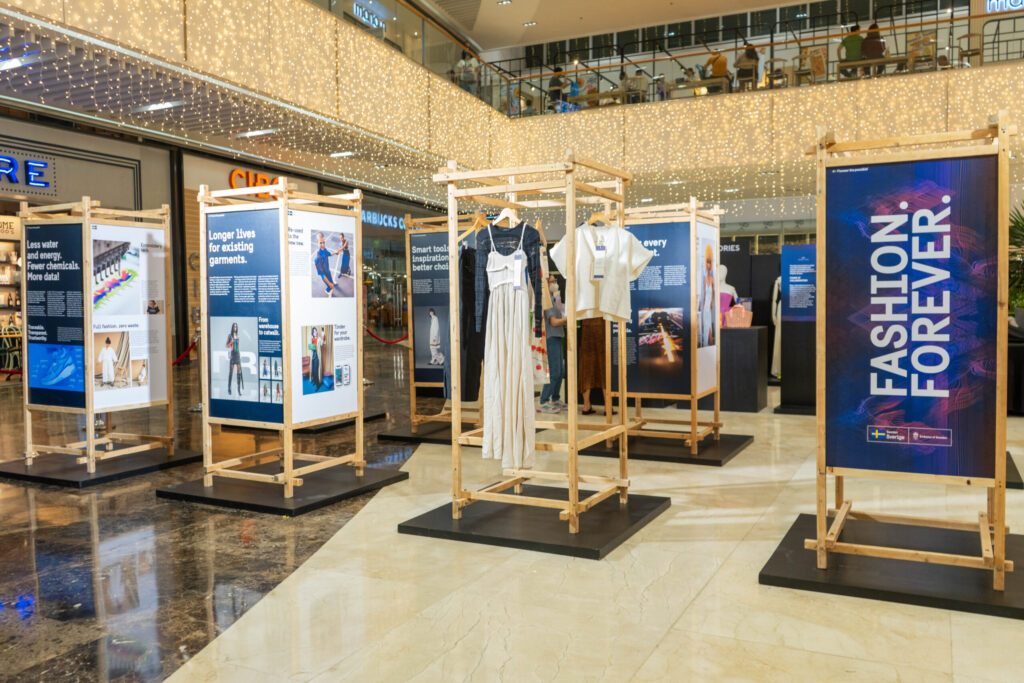A beacon of hope, Sweden is pioneering a future-friendly approach to the fashion industry. The “Fashion Forever” exhibition, ongoing at SM Aura from 8 to 14 September, sheds light on said country’s innovative strides in sustainable fashion design, production and distribution.
Because of the combined efforts of designers, business people and academics who are dedicated to developing a circular fashion sector, the Swedish fashion scene has experienced a remarkable transition. “Fashion Forever” demonstrates Sweden’s commitment to sustainable development by showcasing the cutting edge of eco-friendly materials and clothing.
The Swedish government’s steadfast commitment to sustainability is at the core of this transition. In line with the global Sustainable Development Goals of Agenda 2030 and the Paris Climate Agreement, Sweden wants to set the standard for sustainable fashion production and consumption around the globe.

A standout example from the exhibition is “Textile & Fashion 2030,” a government-supported initiative spearheaded by the University of Borås, in collaboration with the Swedish School of Textiles, SmartTextiles, Science Park Borås and the Research Institute of Sweden. This initiative focuses on researching sustainable fashion techniques in small-scale settings and how brands can scale these innovations globally.
The circular economy, which prioritizes resource efficiency and looks for creative ways to maximize the value of products, residues, dead-stock and textile waste, is the central theme of “Fashion Forever.” The display showcases ground-breaking circularity initiatives undertaken by Siptex and Renewcell.
A ground-breaking facility called Siptex sorts textiles by color and fiber content using near-infrared light, enabling extensive textile recycling.
Circulose® is a dissolving pulp with a high cellulose content that is produced by the textile-to-textile recycling business Renewcell. After that, Circulose® is turned into high-quality textiles including modal, viscose and lyocell fabrics.
The collaboration efforts among Swedish fashion stores, design institutes and scientific parks—all backed by the government—are highlighted by Swedish Ambassador Annika Thunborg. She claims that by making these efforts, the fashion industry is able to maintain its creative, thrilling, and financial viability while still being environmentally responsible and consumer-friendly.
At the exhibition, H&M, a well-known Swedish fashion store dedicated to attaining 100 percent circularity by 2030, presents its “Innovation Stories” program. This effort, which focuses on sustainability, investigates forward-thinking concepts and creative fabrications and designs.

The event also features local companies and creators from the Philippines who support ecological methods, such as Zarah Juan and Lily of the Valley. To reduce superfluous production and create long-lasting clothing and accessories, they work with local resources, handcrafted techniques and made-to-order procedures.
Prioritizing ethically sourced materials and small-scale, community-based production, Zarah Juan is known for its vibrant and uniquely Filipino designs. Lily of the Valley is a pioneer in a take-back program to recycle used and outdated undergarments and offers 100 percent made-to-measure innerwear items to cut down on overproduction.
“Fashion Forever” was started by the Swedish Embassy in Manila with help from the Swedish Institute and collaborations with SM Aura and H&M.
